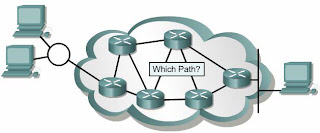Introduction
Wide Area Network (WAN) is a data communication network that connects user-user on the network that is located in a large geographic area. WAN has some important characteristics that distinguish it with the LAN. In the first lesson in this module will be the introduction of the WAN technologies and protocols. And will also explain how the similarities and differences between the LAN and WAN.
Is very important to understand the physical layer components on a router. This knowledge will add to the basic information and skills that will be required to configure the router and set the routing network. This module also describes the techniques of the physical connection of a variety of interface-interface router.
1. WAN
1.1 Introduction WAN
Characteristics of WAN:
- Connect the equipment to spread to the wide geographic area
- Using public service channels, such as telecommunications companies. PT. Telkom, PT. Indosat, PT. Excelcomindo and others to form the network in the geographic area.
- Using a serial connection for access to bandwidth in all the geographic area.
Next is equipment used in the WAN:
- Router, including internetworking and port-port WAN interface
- Modem, including the interface voice-grade, channel service units / digital service units (CSU / DSU), which serves T1/E1 interface, and the Terminal Adapter / Network Termination 1 (TA / NT 1) interface as an Integrated Services Digital Network (ISDN)
- Server dial-in server and user-user who has to dial out to connect

- International Telecommunication Union-Telecommunication Standardization Sector (ITU-T), the Consultative Committee for International Telephone and Telegraph (CCITT)
- International Prganization for Standardization (ISO)
- International Engineering Task Force (IETF)
- Electronics Industries Association (EIA)

- Operates in the geographic area that is very knowledgeable
- Ability to provide serial connection with low cost and low-speed or high cost and high speed, for example via the ATM or fiber optics
- Ability to provide full-time connection and part-time


Same with the PC, a router operating system to function, the Internetwork Operating System (ios) software to run the configuration files. Configuration-configuration contains commands and parameters that control the flow of traffic that enter and exit from the router. Router using routing protocols to determine the best path.
- Save the routing table
- Handling the ARP cache
- Handling the fast-switching cache
- Handling the packet buffering and share RAM
- Handling the queue package
- To provide temporary memory for configuration files at the time of the router to work
- Data will be lost when the router is turned off or restart
NVRAM function and have the following characteristics:
- To provide storage for the startup configuration file
- Data is still there even though the router is turned off or restart
Flash memory has the functions and characteristics as follows:
- Handle ios image
- Providing access to update the software without having to remove the chip on prosesornya
- Data is still there when the router is turned off or restart
- It can store multiple versions of software ios
- Is a type of Electrically Erasable Programmable Read-only memory (EEPROM)
- Handle commands for power-on diagnosis selt test (POST)
- Save bootstap program and basic operating system
- Need to remove the chip on the motherboard when upgrading software
Interface functions and have the following characteristics:
- Connecting to a network router as the exit data entry package
- Only in the motherboard or as a separate module

Router have interface for both LAN and WAN. WAN technology, always use the router. WAN connection using a router to communicate with the other. Router is the backbone equipment from large-scale intranet or the Internet. Router operates at OSI layer 3, making a decision based on the network address. Two of the main function of the router is to select the best path and as a packet-switching and packet data interface to the destination. To perform its function, the router always formed routing table and the exchange of information on the network with the other router.
Internetwork the correct configuration requires the following:
- Address end-to-end must be consistent
- Address used in the network topology
- Elections best path
- Routing dinamic or static
- The process of switching


Standards and protocols, or from the main function of the operation is in the WAN physical layer and data link layer. 5 means the layer was not found in other WAN. In other words, the standard protocol and layer 1 and layer 2 WAN different from the standard protocol and layer 1 and layer 2 of the LAN.
Main function of a router is to send data using a layer 3 address. This process is called routing. Routing occurs at the network layer, or layer 3. If the WAN operate at layer 1, 2 and 3, if the router is the equipment for the LAN or WAN? the answer is both.
Below is a list of standards and protocols on the WAN physical layer:
- EIA/TIA-232
- EIA/TIA-449
- V.24
- V.35
- X.21
- G.703
- EIA-530
- ISDN
- T1, T3, E1 and E3
- XDSL
- SONET (OC-3, OC-12, OC-48, OC-192)
- Frame Relay
- Points-to-Point Protocol (PPP)
- Synchronous Data Link Control (SDLC)
- Serial Line Internet Protocol (SLIP)
- X.25
- ATM
- LAPB
- LAPD
- LAPF








1 comment:
Men99 <-10watt->
Nice Inpo gan.. Anak Cisco ya...
Salam bloging
http://firtstest.wordpress.com
Post a Comment